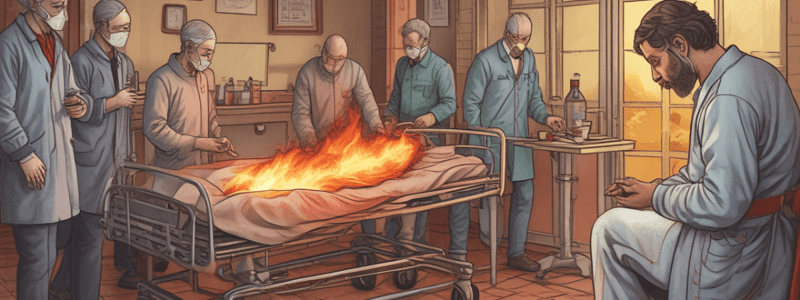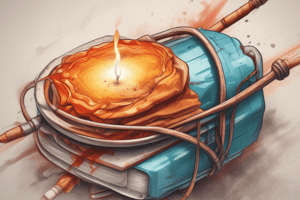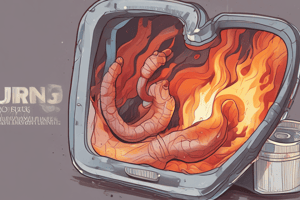Podcast
Questions and Answers
Why is it important to keep the burn patient warm?
Why is it important to keep the burn patient warm?
- To prevent hypoperfusion and deepening of burn wounds (correct)
- To increase the accuracy of estimating burn area
- To prevent respiratory depression
- To reduce the risk of hypovolaemia
What is the purpose of the secondary survey?
What is the purpose of the secondary survey?
- To administer analgesia
- To reassess the burn area
- To initiate fluid resuscitation
- To check for concomitant injuries (correct)
What is the most accurate method of estimating burn area?
What is the most accurate method of estimating burn area?
- Lund and Browder Chart (correct)
- Wallace rule of nines
- Visual estimation
- Palmar surface method
Why is it important to touch the wounds during assessment?
Why is it important to touch the wounds during assessment?
What is the primary goal of fluid resuscitation in burn patients?
What is the primary goal of fluid resuscitation in burn patients?
Why is a urinary catheter mandatory in burns >20% TBSA?
Why is a urinary catheter mandatory in burns >20% TBSA?
What should be excluded when calculating burn area?
What should be excluded when calculating burn area?
What is the minimum percentage of full thickness burns required for transfer to a Red Cross Hospital in children?
What is the minimum percentage of full thickness burns required for transfer to a Red Cross Hospital in children?
What is the dosage of IV morphine for large burn patients?
What is the dosage of IV morphine for large burn patients?
What is the primary goal of in-hospital care for burns patients?
What is the primary goal of in-hospital care for burns patients?
What is the maximum percentage of body surface area that can be covered in a single sitting with autologous split skin grafts?
What is the maximum percentage of body surface area that can be covered in a single sitting with autologous split skin grafts?
What is the primary role of a dietician in the rehabilitation of burns patients?
What is the primary role of a dietician in the rehabilitation of burns patients?
What is a common indication of futile care in burns patients?
What is a common indication of futile care in burns patients?
What is the primary purpose of early chest physiotherapy in burns patients?
What is the primary purpose of early chest physiotherapy in burns patients?
What is the primary focus of the modified ATLS primary survey in the initial assessment of a major burn?
What is the primary focus of the modified ATLS primary survey in the initial assessment of a major burn?
What is a sign of inhalational injury?
What is a sign of inhalational injury?
When should intubation be considered in a burn patient?
When should intubation be considered in a burn patient?
What is a complication of ventilation in burn patients?
What is a complication of ventilation in burn patients?
What is the effect of carboxyhaemoglobin (COHb) on the body?
What is the effect of carboxyhaemoglobin (COHb) on the body?
What is the indication for ventilation in a burn patient with COHb levels greater than 25-30%?
What is the indication for ventilation in a burn patient with COHb levels greater than 25-30%?
What is the preferred method of establishing IV access in a burn patient?
What is the preferred method of establishing IV access in a burn patient?
What is a sign of neurological disability in a burn patient?
What is a sign of neurological disability in a burn patient?
What is the primary cause of hypovolaemia in a burn patient?
What is the primary cause of hypovolaemia in a burn patient?
What is the indication for a CXR in a burn patient?
What is the indication for a CXR in a burn patient?
What is a key consideration when assessing burn area in individuals with pigmented skin?
What is a key consideration when assessing burn area in individuals with pigmented skin?
What is the primary factor in determining the likelihood of mortality in burn patients?
What is the primary factor in determining the likelihood of mortality in burn patients?
What is the purpose of the Parkland's formula in burn patient care?
What is the purpose of the Parkland's formula in burn patient care?
Which of the following patient groups may require extra fluid requirements?
Which of the following patient groups may require extra fluid requirements?
What is the primary purpose of fluid resuscitation regimens in burn patient care?
What is the primary purpose of fluid resuscitation regimens in burn patient care?
When should fluid resuscitation be initiated in burn patients?
When should fluid resuscitation be initiated in burn patients?
Flashcards are hidden until you start studying
Study Notes
Initial Assessment of a Major Burn
- Primary survey is similar to any trauma patient, with emphasis on airway and breathing assessment
- Modified ATLS primary survey is performed to avoid missing associated injuries
- Airway assessment includes signs of inhalational injury:
- History of flame burns or burns in an enclosed space
- Deep dermal or full thickness burns to face, neck, or upper torso
- Singed nasal hair
- Carbonaceous sputum or carbon particles in oropharynx
- Indications for intubation:
- Erythema or swelling of oropharynx on direct visualization
- Change in voice, hoarseness, or harsh cough
- Stridor, tachypnoea, or dyspnoea
- Breathing assessment:
- All burn patients receive humidified oxygen via a non-rebreathing mask
- Mechanical restriction of breathing can occur due to deep dermal or full thickness circumferential burns of the chest
- Blast injury can cause lung contusions and alveolar trauma, leading to ARDS
- Smoke inhalation can cause bronchospasm, inflammation, bronchorrhoea, and impaired ciliary action
Initial Assessment (continued)
- Circulation assessment:
- Establish IV access with 2 large bore cannulas, preferably through unburnt skin
- Profound hypovolaemia is not a normal initial response to a burn
- Hypotension may be due to delayed presentation, cardiogenic dysfunction, or occult blood loss
- Disability assessment:
- Assess GCS
- Confusion may be due to hypoxia or hypovolaemia
- Exposure and environmental control:
- Fully assess burn area and depth
- Check for concomitant injuries
- Keep the patient warm to prevent hypothermia
- Fluid resuscitation:
- Use guidelines, with adjustments based on urine output, pulse, BP, and RR
- Monitor resuscitation status with regular investigations (plasma sodium, base excess, lactate, and packed cell volume)
Assessment of Burn Area
- Three common methods of estimating burn area:
- Palmar surface (1% TBSA, less accurate for medium-sized burns)
- Wallace rules of nines (quick estimate, not accurate in children)
- Lund and Browder chart (most accurate, compensates for variation in body shape with age)
- Important to expose and assess all of the burn area, remove loose epidermal layers, and calculate burn size
Fluid Resuscitation Regimens
- Formulas estimate fluid requirements, but adjust according to urine output, pulse, BP, and RR
- Certain patient groups require extra fluid: children, inhalational injury, electrical injury, delayed resuscitation, and dehydration
In-Hospital Care
- Prevent sepsis
- Cover with silver-containing cream
- Debride blisters
- Resuscitate
- Early enteral feeding
- Early excision and biological wound coverage
Rehabilitation
- Early chest physio
- Early mobilisation
- Post-graft splinting
- ADL adaptation
- Compression garments and dynamic hand splints
- Social Worker, Psychologist, Dietician, Pastor/Imam/Rabbi, Family, and Community support
- Reconstructive (plastic) surgeon
Studying That Suits You
Use AI to generate personalized quizzes and flashcards to suit your learning preferences.




